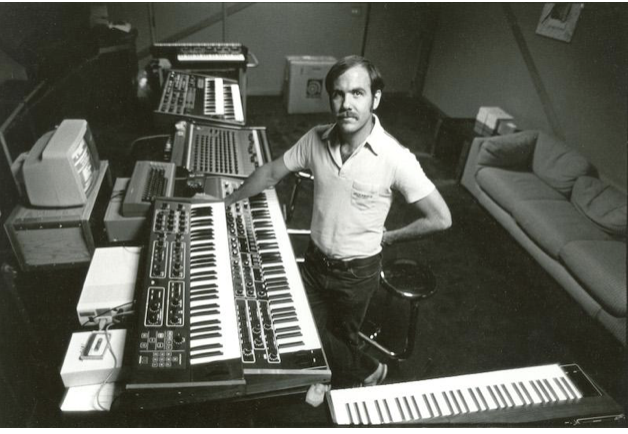
The Bob Moog Foundation announced today that the family of Dave Smith, synthesizer and MIDI pioneer, is honoring his legacy through the Foundation’s Captains of Industry program.
Dave posthumously joins industry innovators Tom Oberheim, Spectrasonics, Hans Zimmer, Ray Kurzweil, Marcus Ryle, Ernst Nathorst-Böös, Izotope, Christopher Kemper, Chris Halaby, Universal Audio, Gehard Behles, 8Dio, Larry Thomas, John Worthington, and Daniel Haver, who empower the Foundation’s work with a donation of $5,000 annually over a three-year period.
 Dave Smith, engineer and founder of Sequential Circuits, created the first polyphonic synthesizer with a fully programmable memory, the Prophet-5, which had a marked impact on the music technology industry. A long line of innovative instruments followed. He also spearheaded the development of MIDI, which revolutionized the way that musicians create music. In 2013, he won a Grammy award alongside Ikutaro Kakehashi of Roland for their contributions to the development of MIDI. Dave often recalled getting his start with the purchase of his very first synthesizer, a Minimoog.
Dave Smith, engineer and founder of Sequential Circuits, created the first polyphonic synthesizer with a fully programmable memory, the Prophet-5, which had a marked impact on the music technology industry. A long line of innovative instruments followed. He also spearheaded the development of MIDI, which revolutionized the way that musicians create music. In 2013, he won a Grammy award alongside Ikutaro Kakehashi of Roland for their contributions to the development of MIDI. Dave often recalled getting his start with the purchase of his very first synthesizer, a Minimoog.
“Throughout his 50-year career, Dave never lost his passion or enthusiasm for designing electronic musical instruments,” noted Dave’s wife, Denise Smith. “He thoroughly enjoyed the creativity, collaboration, friendships, and fun the music industry brought to his life. We both support the Bob Moog Foundation and all they do to excite, ignite, and inspire young minds to continue the story of synthesis.”
 Dave Smith’s participation in the Captains of Industry campaign is being creatively recognized with a virtual synthesizer module, part of a larger Captains of Industry virtual modular where each participant is honored with their own custom module designed by renowned synthesizer designer Axel Hartmann. Dave’s module gives a nod to his company, Sequential, his revolutionary Prophet-5 synthesizer, his role in the invention of MIDI, and his Technical GRAMMY Award for that development.
Dave Smith’s participation in the Captains of Industry campaign is being creatively recognized with a virtual synthesizer module, part of a larger Captains of Industry virtual modular where each participant is honored with their own custom module designed by renowned synthesizer designer Axel Hartmann. Dave’s module gives a nod to his company, Sequential, his revolutionary Prophet-5 synthesizer, his role in the invention of MIDI, and his Technical GRAMMY Award for that development.
The funding generated by the Captains of Industry campaign lends critical assistance to inspiring future innovators through the Foundation’s education and archival preservation projects including Dr. Bob’s SoundSchool, the Bob Moog Foundation Archives, and the Moogseum.
Dr Bob’s SoundSchool currently reaches 3,000 students annually, with 25,000 elementary school children inspired over the last nine years, stimulating critical thinking and inspiring future professional endeavors in science, music, technology, and engineering. The Moogseum has welcomed over 27,000 visitors from around the world since its inception in late 2019, while the Bob Moog Foundation Archives’ vast collection of over 10,000 items serve as a historical resource for other museums, researchers, and journalists
“We are deeply moved that Dave’s family has chosen to remember his legacy through our Captains of Industry campaign. While our work begins with Bob’s legacy, we have dedicated ourselves to honoring electronic music pioneers of all kinds through our work over the past 17 years. Dave Smith has a large presence in our Moogseum, and was most recently featured in our Synthesizer Pioneers calendar, to which he donated rare photographs and historical insights. The story of Sequential Circuits, The Prophet from Silicon Valley, has been available in our Moogseum store since we opened. We consider Dave to not only have been a friend of the Foundation, but to be an ongoing part of the fabric of our work.” – Michelle Moog-Koussa, Bob Moog Foundation Executive Director
To learn more about how you or your business can participate in the Bob Moog Foundation’s Captains of Industry program, please contact captainsofindustry@moogfoundation.org.

Ted Lasso’s baby brother. wow the T8 was a monster.
The T8 keyboard was a bit sluggish, like a Roland DP, but in that case, it didn’t matter; it was built to be a synth. The feel was amazing in that context. It spoiled me for lesser actions & responsiveness. That’s generally what you get when you pay 5 thou or so instead of just 2 or 3. It has its own character, but its nearest peer at the time was the CS-80. The image of the CS-80 now is like tales of a great grandfather who could fly, but you never saw it happen.
Dave circled a main idea of what made for a good synth, but his variations were distinct and creative. Its proper for him to be included here.